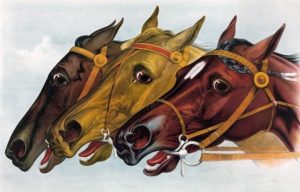Which horse has won the Grand National by the widest margin?
Verifying exactly which horse has won the Grand National by the widest margin is not as a straightforward as it might appear. The ‘length’ has been the standard measure of winning distances since time immemorial but, in modern horse racing, distances are determined by reference to a computerised lengths-per-second (LPS) table, which takes into account the prevailing going and other variables. Nowadays, racecourse judges can record meaningful distances up to, and including, 200 lengths.
However, until just over a decade ago, any distance beyond 30 lengths was simply recorded as ‘a distance’. As far as the Grand National is concerned, six horses – Cloister (1893), Covertcoat (1913), Shaun Splash (1921), Tipperary Tim (1928), Mr What (1958) and Red Marauder (2001) – are credited with having won by a distance. Several reputable sources state that Cloister, who was also the first horse to defy 12st 7lb in the Grand National, won by 40 lengths and therefore holds the record for the widest margin win in history. However, none of them reveal how the figure of 40 lengths was arrived at.
Certainly, the most attritional renewal of the Grand National in recent times occurred in 2001. On nigh on bottomless ground, Red Marauder beat Smarty – who was the only other horse to complete the National Course unscathed – by a distance, with a further distance back to the remounted pair Blowing Wind and Papillon, who were also separated by a distance.
 Ultimately, what happened to Shergar will probably never be known conclusively. What is known, beyond shadow of doubt, is that he was abducted from the Ballymany Stud, in Co. Kildare, Ireland by a gang of masked gunmen in February, 1983, and never seen again, dead or alive. The gunmen were believed to be members of the Irish Republic Army (IRA) but, possibly because of manner in which Shergar met his end, no-one has ever claimed responsibility for the abduction.
Ultimately, what happened to Shergar will probably never be known conclusively. What is known, beyond shadow of doubt, is that he was abducted from the Ballymany Stud, in Co. Kildare, Ireland by a gang of masked gunmen in February, 1983, and never seen again, dead or alive. The gunmen were believed to be members of the Irish Republic Army (IRA) but, possibly because of manner in which Shergar met his end, no-one has ever claimed responsibility for the abduction.